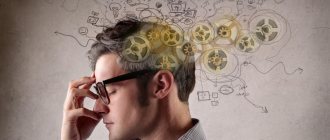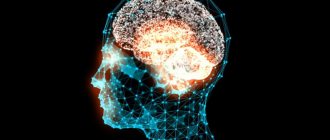Intelligence... With this word, many of us feel a kind of pride, since it is known that a person possesses it to the highest degree. Some even think that intelligence is something that only humans have. We will have to disappoint them: animals also have intelligence. Some even try to speculate about its presence in plants and other groups of organisms, but so far this has not gone beyond the bounds of science fiction. Recently, developments in the field of artificial intelligence have achieved great results.
What is intelligence
Intelligence
is the mental ability of the body, expressed in the ability to solve various problems, cope with problems, carry out cognitive activity, adapt to changing environmental conditions and manage it.
Intelligence is manifested in educational, research, work activities, communication and social life in general. This concept unites individual cognitive abilities: sensations, perception, memory, ideas, thinking, imagination, will, reflection, attention.
The concept of intelligence arose relatively recently - only at the end of the nineteenth century. At that time, psychology was developing at a rapid pace, and researchers were studying the mental abilities of humans and animals. Sometimes they made serious mistakes. Thus, at that time, the prevailing belief was that a person uses only a few percent of his brain, while the rest of it remains unused. In everyday life, this idea still persists, but it is fundamentally incorrect and was refuted by science a long time ago. But how could such an assumption even arise? The fact is that at the end of the nineteenth century the functions of a significant part of the brain were not yet studied, and researchers could not understand what they were needed for. In addition, some processes in the brain occur as if in an automatic mode, without the participation of human consciousness. That is, it seems to us that some part of the brain is inactive, but in fact it carries out extremely important work unnoticed by us, without which, probably, intelligence itself would become impossible.
However, the issue of the relationship between intelligence and the brain is quite complex. Does man have intelligence? Of course there is. But does a cat have it? Probably there is too. What about the lizard? One might think that she has it too. What about an ant, a microbe, a plant? At first glance, it seems that the more developed the organism, the more we can talk about the presence of intelligence. But here, too, not everything is so simple.
Ants, like all other insects, do not have a brain at all. Their "brains", dispersed throughout the body, are a primitive nerve cluster. And the entire structure of the ant organism is very primitive. Meanwhile, some even seriously compare the intellectual abilities of ants with those of humans. Ants can accumulate and transmit information, communicate, learn, and they have a complex hierarchy. They can navigate the terrain; recent research shows that they apparently can even count. In ant society there are many “professions”, the variety of which varies for each species. In fact, the life of an anthill is very reminiscent of human society.
A lizard is an organism of a completely different kind. Its overall development is tens of times more complex and organized than that of an ant. And there is a full-fledged brain, and a fairly developed one at that. But the intellectual abilities of a lizard are very modest and cannot be compared with the intelligence of an ant (and even more so a human).
It turns out that intelligence is more of a function than a certain material structure. Intellectual activity can be realized in various ways.
How is this function implemented? The implementation of an intellectual function occurs through the work of its components: this is the ability to find connections between disparate data, synthesize and analyze, compare, classify, build associations, etc. Each such ability separately does not form intelligence, it can only be discussed in the aggregate of these abilities .
Features of the human intellectual system consist of several parameters
:
- Working memory capacity, ability to predict, use tools, logic;
- Multi-level hierarchy of selection of valuable information - six layers of neurons are involved in this;
- Consciousness;
- Memory.
Intelligence does not appear suddenly and on its own, but develops over time. The intellectual level of a person can be increased through special techniques; it can also decrease due to various circumstances (old age, head injuries, mental illness, etc.).
Types and functions
Scientists have been trying to create an accurate classification of types of intelligence since the beginning of the 20th century, but it has been a difficult process. The most popular classification, which is accepted by most scientists, was compiled by Howard Gardner. He identified 8 types of intelligence:
- Verbal-linguistic. Implies a developed ability to receive and transmit information using well-delivered speech. This type of intelligence presupposes the presence of certain qualities in an individual - the ability to meaningfully perceive and analyze speech sounds, their combination, compose complete sentences depending on language requirements, write logical texts in different styles.
- Logical-mathematical. Implies developed mathematical abilities and logical thinking. It is characterized by a number of qualities - the ability to organize thoughts, build concepts according to a hierarchy of significance, work with different databases, operate with numbers, structure, and systematize data.
- Naturalistic. Characterized by the ability to analyze various events occurring in the surrounding world and draw appropriate conclusions. With the help of this intelligence, man was able to evolve and adapt to new conditions of existence.
- Visual-spatial. It is characterized by a developed ability to navigate in space, to perceive the exact shape of surrounding objects, their location relative to other objects, and the ability to accurately guess the distance between individual objects. The main manifestations are a developed imagination, the ability to create, process, and save different images, the ability to transfer invented images into drawings, music, and texts.
- Interpersonal. Involves developing communication skills with other people. Qualities - the ability to obey, work in a team, lead others, mastery of various methods of verbal and non-verbal communication, organizational skills.
- Kinesthetic. It is called bodily or tactile. Implies effective knowledge of the world through movements, touches, sensations. People with developed kinesthetic intelligence are characterized by achievements in blacksmithing, carpentry, and sculpture making.
- Musical and rhythmic. A person has developed mental abilities in identifying different sounds, notes, tones, a sense of rhythm, and understanding melodies. People with a high level of intelligence become outstanding musicians.
- Intrapersonal. Characterized by a strong connection between self-awareness and mental abilities. This type of intelligence is characterized by a readiness for solitude, a tendency to reflection, and introspection. Such individuals know how and love to immerse themselves in their inner world, avoiding surrounding problems.
A separate type of intelligence that is not included in the classification is emotional. Scientists began to talk about its importance only towards the end of the 20th century. It is characterized by a person’s ability to emotionally understand the world around him and other people.
Functions:
- Help in occupying a certain position in society.
- Gaining knowledge, mastering skills, developing existing skills.
- Demonstration of talents, achievement of success in various fields of activity.
- Self-affirmation, self-realization.
Intelligence helps a person survive in different realities of the world around him and adapt to changing conditions.
What types of intelligence are there?
A major researcher in the field of intellectual development, Raymond Cattell, believed that intelligence should be divided into two types - mobile and crystallized. The first is based on logical operations, the ability to solve problems that go beyond the limits of existing experience. The second is based on accumulated experience and the ability to use existing knowledge and skills.
There is also a division into emotional and social intelligence. The first is the ability to recognize and understand your own emotions and the emotions of those around you. The second type is the ability to understand people's behavior. Social intelligence is the most important part of a person’s social life; it allows you to interact with other people and build various relationships. Researchers emphasize that the purpose of such intelligence is not depth of understanding, but social adaptation.
The diversity of types and forms of intelligence can be judged, for example, by the cultural characteristics of different peoples. For example, the Negroid race has the most highly developed concrete visual and plastic thinking. The people of Africa are good artists and excellent dancers; they can depict by hand what Europeans are accustomed to depicting only with the help of computer graphics. Drawing and dance in Africa play the role of original “alphabets” from which special languages are composed. European thinking is abstract. Painting and dance in European culture are considered an art, that is, a skill accessible to few; at the same time, the sound-letter alphabet, reasoning in abstract categories, understanding of such phenomena as law, justice, order, etc. are developed. The Asian peoples of the Mongoloid race are carriers of “symbolic” thinking. Their symbolic (hieroglyphic) alphabet and system of allegories have reached a high level of development; the culture is replete with symbols that lack practical meaning and express complex ideas, and rituals and ceremonies play a significant role in behavior.
There are other ways to divide intelligence. Thus, they distinguish between logical and spatial intelligence, and the latter is divided into physical, social, spiritual, creative, and emotional.
Diagnostics
Intelligence studies are carried out on the basis of various methods and techniques. All of them are based on two principles: testing and experimentation. For example, logical thinking and pattern identification skills are revealed using Raven's progressive matrices. Amthauer tests specialize in orientation in professional activities. Both the first and second technologies are developed for people of different ages. To evaluate a child, the Goodenough-Harris method is suitable, which gives an assessment based on a child’s drawing. All these developments are decades old, they are unified and give average readings.
Ask a question
Levels of intellectual activity
There is such a thing in psychology as levels of intellectual activity.
Researchers identify three such levels
:
- Stimulus-productive – when mental activity is caused only by the influence of external factors.
- Heuristic is a spontaneous cognitive activity that leads to the discovery of a number of patterns.
- Creative is the highest level of mental activity, at which there is a full penetration into the essence of the things being studied, solving existing problems and setting new tasks.
At the first level, intellectual activity is limited to a given or initially found path. A person can study various phenomena and solve various problems, but only as private ones, without connection with each other. At this level, however, the intellectual can put forward quite bold hypotheses.
At the second level, the researcher can compare disparate phenomena and problems and find something in common in them, identify new patterns. In this case, knowledge occurs empirically.
At the third level, comparing different phenomena and finding what they have in common becomes not just a separate technique, but is itself a problem that requires deep insight into the essence of things. In this case, the researcher uses the theoretical path of knowledge.
Intellectual actions of an individual are divided into levels in another way.
In this case, there are two levels
:
- Personal actions at the level of a social individual, while human activity is determined by the task and desired results.
- Actions of a creative person; in this case, the result turns out to be broader than the stated goal and gives rise to new tasks.
The activity of the individual gradually ceases to be a response to the initially set task and takes on a creative character.
The division of the work of the intellect into levels also reflects the history of the development of mental activity in humans. That is, the first people passively solved the problems facing them, formed by nature itself, and strived for biological survival; knowledge was more of an adaptive nature. Subsequently, primitive “scientific” activity appeared, when, through searches, trial and error (empirically), people found new patterns in the structure of the surrounding world and tried to use them in their practice. Finally, at the very latest time, a theoretical science was formed that had a developed methodological apparatus and deep criteria for knowing the truth.
For clarity, you can also use Maslow’s famous pyramid, which reflects the hierarchy of human needs. It shows that the need for creativity and spiritual development is the highest, and to achieve it you need to go through lower levels. In accordance with this, the intellect works: at first it is aimed at achieving pressing goals and solving specific problems (finding food, housing, achieving material well-being), then opportunities arise for learning something new, and at the highest level the opportunity arises for creative activities.
Models and structure of intelligence
Intelligence is the stable structure of an individual’s mental abilities, the level of his cognitive capabilities, the mechanism of an individual’s mental adaptation to life.
Structure (from Latin structura - structure, arrangement, order) is a set of stable connections and relationships of an object that ensure its integrity and identity with itself, that is, the preservation of basic properties under various external and internal changes.
The structure of intelligence according to H. Eysenck - (from lat.structura - insertion and lat.intellectus - mind) - a model of intelligence; it highlights elements such as:
- Speed of mental operations
- persistence and
- tendency to check errors,
on the basis of which the IQ level is determined.
The structure of intelligence according to G. Gardner is a model of intelligence; consists of independent modules:
- formal linguistic,
- spatial,
- logical-mathematical,
- musical,
- engine,
- interpersonal,
- intrapersonal;
Different cultures emphasize the formation of different modules, each of which is represented by vertically arranged levels:
- Perception,
- memorization
- education.
The structure of intelligence according to R. Cattell is a factor-analytic theory that distinguishes two types of intelligence:
- A fluid that is largely dependent on heredity - and plays a role in tasks that require adaptation to new situations, and
- Crystallized intelligence that reflects past experiences. In addition to general intelligence factors, this approach identifies individual factors determined by the work of individual analyzers, for example, the visualization factor, as well as operational factors corresponding to specific Spearman factors.
As Spearman's research has shown, with age, especially after 40-50 years, there is a decrease in liquid intelligence, but not crystal intelligence.
The structure of intelligence according to R. Sternberg is a classification that distinguishes three types of thought processes:
- verbal intelligence - characterized by vocabulary, erudition, reading comprehension;
- problem solving ability;
- practical intelligence as the ability to achieve goals.
Structure of intelligence according to E.P. Torrance - model of intelligence; it highlights elements such as language understanding,
- spatial representations,
- inductive reasoning,
- calculation,
- memory,
- perceptual fluency,
- eloquence.
The structure of intelligence according to K. Spearman is a factor-analytic theory of the general factor, in which intelligence is considered as a certain mental energy, the level of which determines success in solving test tasks of any type. According to this theory, the general intelligence factor has the greatest weight when performing abstract relational tasks and the least weight when performing sensory tasks. In addition to the general factor of intelligence, there are also group factors of intelligence that can be classified into.
- mechanical,
- linguistic,
- mathematical abilities;
as well as special factors unique to individual intelligence tests.
The structure of creative talent of A.M. Matyushkina - the following components are distinguished:
- The dominant role of cognitive motivation;
- research creative activity, expressed in the discovery of new things, posing and solving problems;
- ability to come up with original solutions;
- ability to predict and anticipate;
- the ability to create ideal standards of high aesthetic, moral and intellectual appreciation.
Intelligence quotient: methods of determination
Intelligence quotient - the famous IQ - determines the degree of development of a person’s mental activity. It is sometimes used to evaluate the mental abilities of animals in comparison with humans. Researchers have even determined the IQ of creatures such as the earthworm.
The coefficient is determined using special tests that allow you to find out various factors, for example
:
- Level of intelligence development in comparison with the average person (of the same or middle age);
- The “intellectual age” of a person in comparison with his biological age;
- The presence or absence of mental pathology.
Creating IQ tests is a rather difficult task. Their results should be described by the so-called “normal distribution” of indicators, or Gaussian distribution. This means that 50 percent of people would have an IQ between 85 and 115, and 25 percent of people would have an IQ below 90 and above 110. An IQ value of less than 70 is defined as mental retardation.
History of the study
The question of studying intellectual abilities arose especially acutely for scientists in the 19th century. By 1905, French scientists T. Simon and A. Binet were able to develop the first tests that were designed to assess the level of mental abilities in children aged 3–13 years. The creators of the texts themselves considered intelligence as a level of development of mental health inherent in a certain age. The assessment was based on the number of correct answers and their ratio to errors.
The next breakthrough in this area occurred in 1912. Then the German psychologist W. Stern proposed making assessments of the level of mental development by calculating the IQ. He called them the relationship between the chronological and mental age of the child.
The teachings of V. Stern were continued by L. Theremin. He adapted the proposed coefficient for US residents, brought it under the Binet-Simon scale, for which he came up with some changes to modify it. Thanks to the work of L. Theremin, a new scale for assessing intelligence was developed.
The first full-fledged IQ test was proposed by D. Wexler. He proposed a detailed classification of levels of development of mental abilities, which was based on the frequency of occurrence of the indicator:
- intellectual decline - up to 69;
- borderline level - from 70 to 79;
- reduced rate - from 80 to 89;
- average level - from 90 to 109;
- a good indicator is from 110 to 119;
- high level - from 120 to 129;
- very high level - over 130.
Over time, the scale was refined and changed depending on current realities. More informative tests were compiled for it.
What factors influence a person's mental abilities?
The level of intelligence can vary significantly among different people. Among us there are intellectuals, slow-witted people, people with average abilities and those who are commonly called mentally retarded. But why are people so different mentally?
Various studies have shown that the formation of human mental abilities is influenced primarily by genetic factors. Upbringing, environmental influences and random external influences play a much smaller role.
However, the external environment also has a certain significance for the formation of intelligence. These are factors such as the standard of living of the family, the level of education of parents, the nature of upbringing, the availability of school education for children (in American studies, students from good urban schools turned out to be more intellectual than students from modest rural schools). Research has even established the influence of such individual factors as annual family income, the size of the house and its cost, the relationship between parents, etc.
The role of nutrition cannot be ruled out. The brain is a rather voracious structure, and a lack of nutrients can lead to a decrease in its ability to process information.
Differences in the intellectual development of men and women
Since ancient times, society has been dominated by the view of women as inferior beings and less developed than men. Traditions and laws that do not allow women to engage in certain types of activities have led to the emergence of the myth that women's intelligence is developed significantly lower than men's. Because of this, it was believed that a woman should “know her place” and not interfere in “men’s affairs,” otherwise nothing good will come of it.
The easing of the position of women and their equal rights with men have shown that women's intelligence is in no way inferior to men's. Moreover, women cope with some types of mental activity much more successfully than men.
But the old attitudes still prevail in many countries: in the popular consciousness, women appear more stupid and undeveloped, and they are assigned a secondary and subordinate role. A woman cannot be the head of the family, she cannot inherit parental property, and in some places women are even prohibited from driving a car. There are also ideas about the inferiority of intelligence among women in the lower strata of the population of developed countries. As a rule, such people tend to take wishful thinking. They are guided by highly outdated scientific information, as well as myths and legends, and religious dogmas. They prefer not to acknowledge more current information because it does not correspond to their personal ideas.
Research into the relationship between sex and brain development has been going on for a long time. The available results show that there are differences in the structure of the brain between men and women, but they are not decisive in terms of intelligence: men and women can perform the same tasks equally successfully.
Thus, it has been shown that the volume and mass of the brain in men is slightly larger than in women. However, this did not have a significant effect on mental abilities. Results from studies of the effects of hormones on intelligence have been controversial; It has been shown that high levels of certain hormones can either increase or decrease mental performance.
Other studies have shown that although the male brain is slightly larger, it is markedly more vulnerable to developmental disorders in the womb. Thus, poor nutrition of the mother during pregnancy in many cases reduces the mental abilities of born boys, but this does not affect girls in any way.
Separate studies have been conducted on the perception of stereotypes. And they showed that in societies where women are exposed to adverse psychological influences, their intelligence levels actually turned out to be lower than in societies where women are perceived as equal to men and treated with respect. The thing is that in conditions of constant humiliation, women use to a greater extent those areas of the brain that are responsible for emotional reactions, and those areas that are responsible for solving certain problems remain unclaimed and do not receive development.
Stereotypes influence in other ways; for example, through raising children. From childhood, in traditional societies, girls are taught to do one type of activity and boys to another. Often, girls are not allowed to study physics, mathematics and other sciences, because it is believed that they will not need it in life. Because of this, boys' and girls' brains are trained to different degrees and in different ways, resulting in very different abilities at a certain age.
World of Psychology
to the Table of Contents
Chapter 3. Psychology of cognitive processes
Intelligence
Currently, there are at least three interpretations of the concept of intelligence:
- Biological interpretation: “the ability to consciously adapt to a new situation.”
- Pedagogical interpretation: “ability to learn, learnability.”
- The structural approach formulated by A. Binet: intelligence as “the ability to adapt means to ends.” From the point of view of the structural approach, intelligence is a set of certain abilities.
The totality of a person’s cognitive processes determines his intelligence.
“Intelligence is the global ability to act intelligently, think rationally, and cope well with life’s circumstances” (Wechsler), i.e.
Intelligence is seen as a person's ability to adapt to the environment.
Most researchers came to the conclusion that the level of general intellectual activity is constant for an individual. “The mind maintains its power unchanged,” Spearman noted. In 1930, this was confirmed by Lashley's experiments on animals. Another 3. Freud introduced the term “psychic energy”, and subsequently the concept of G-factor (from the word General) appeared as the general fund of mental activity. A.F. Lazursky formulated three main levels of activity:
- Lowest level. The individual is unadapted, the environment suppresses the weak psyche of a poorly gifted person.
- Average level. A person adapts well to the environment and finds a place that corresponds to the internal psychological make-up (endopsyche).
- Highest level. Characterized by a desire to remake the environment.
What is the structure of intelligence? There are various concepts that have tried to answer this question. Thus, at the beginning of the century, Spearman (1904) formulated the following postulates: intelligence does not depend on other personal traits of a person; intelligence does not include non-intellectual qualities (interests, achievement motivation, anxiety, etc.) in its structure. Intelligence acts as a general factor of mental energy. Spearman showed that the success of any intellectual activity depends on a certain general factor, a general ability, thus he identified the general factor of intelligence (G factor) and the S factor, which serves as an indicator of specific abilities. From Spearman's point of view, each person is characterized by a certain level of general intelligence, which determines how that person adapts to the environment. In addition, all people have developed specific abilities to varying degrees, which manifest themselves in solving specific problems. Subsequently, Eysenck interpreted the general factor as the speed of information processing by the central nervous system (mental pace). To assess and diagnose the general factor of intelligence, Eysenck's speed intelligence tests, the Progressive Matrices test (D. Ravena), and Cattell's intelligence tests are used.
Later, Thurstone (1938) used statistical factor methods to study various aspects of general intelligence, which he called primary mental potencies. He identified seven such potencies:
- counting ability, i.e. ability to manipulate numbers and perform arithmetic operations;
- verbal (verbal) flexibility, i.e. the ease with which a person can explain himself using the most appropriate words;
- verbal perception, i.e. ability to understand spoken and written language;
- spatial orientation, or the ability to imagine various objects and shapes in space;
- memory;
- reasoning ability;
- the speed of perception of similarities or differences between objects and images.
Factors of intelligence, or primary mental potencies, as further research has shown, are correlated and connected with each other, which indicates the existence of a single general factor.
Later, Guilford (1959) identified 120 intelligence factors, based on what mental operations they are needed for, what results these operations lead to, and what their content is (the content can be figurative, symbolic, semantic, behavioral). By operation, Guilford understands a person’s skill, or rather, a mental process - concept, memory, divergent productivity, convergent productivity, evaluation. Results - the form in which information is processed by the subject: element, classes, relationships, systems, types of transformations and conclusions. Currently, appropriate tests have been selected to diagnose more than 100 factors indicated by Guilford.
According to Cattell (1967), each of us already has a potential intelligence from birth, which underlies our ability to think, abstract and reason. Around the age of 20, this intelligence reaches its greatest flowering. On the other hand, “crystalline” intelligence is formed, consisting of various skills and knowledge that we acquire as we accumulate life experience. “Crystalline” intelligence is formed precisely when solving problems of adaptation to the environment and requires the development of some abilities at the expense of others, as well as the acquisition of specific skills. Thus, “crystal intelligence” is determined by the measure of mastery of the culture of the society to which a person belongs. The factor of potential or free intelligence correlates with the factor of “crystalline or bound intelligence”, since potential intelligence determines the primary accumulation of knowledge. From Cattell's point of view, potential or free intelligence is independent of cultural participation.
Rice. 3.2 Structure of intelligence according to Guilford. His cubic model identifies 120 specific abilities based on three dimensions of thinking: what we think about (content), how we think about it (operation), and what mental action leads to (result). For example, when learning Morse code signals (EI2), when memorizing the semantic transformations necessary to conjugate a verb in a particular tense (DUS), or when assessing behavioral measurements when it is necessary to take a new path to work (AV4), people are completely involved different types of intelligence.
Its level is determined by the level of development of the tertiary zones of the cerebral cortex. Partial or partial factors of intelligence (for example, Visualization - manipulation of visual images) are determined by the level of development of individual sensory and motor areas of the brain. Cattell tried to construct a test, free from the influence of culture, on specific spatial-geometric material (“culture-free intelligence test”).
Hebb (1974) views intelligence from a slightly different perspective. He highlights intelligence A - this is the potential that is created at the moment of conception and serves as the basis for the development of an individual’s intellectual abilities. As for intelligence B, it is formed as a result of the interaction of this potential intelligence with the environment. You can only evaluate this “resulting” intelligence by observing how a person performs mental operations. Therefore, we will never be able to know what A's intelligence was.
In hierarchical models of intelligence (the most popular model is F. Vernon), the general factor according to Spearman is placed at the top of the hierarchy; at the next level there are two main group factors: verbal-educational abilities (verbal-logical thinking) and practical-technical abilities (visual-logical thinking). effective thinking). At the third level are special abilities: technical thinking, arithmetic ability, etc., and finally, at the bottom of the hierarchical tree, more specific subfactors are placed. Wechsler intelligence tests, widely used to diagnose intelligence, are created on the basis of this hierarchical model of intelligence. Wexler believed that verbal intelligence reflects a person’s acquired abilities, and nonverbal intelligence reflects his natural psychophysiological capabilities. The results of studies conducted on twins show that, on the contrary, scores on the verbal tasks of the Wechsler test are predominantly hereditary, and the success of nonverbal tests depends on social factors, experience, and the person (with repeated testing, the success of solving nonverbal tests increases more significantly than the success of verbal decisions - the learning effect is stronger).
The development of intelligence depends on congenital factors: genetic factors of heredity, chromosomal abnormalities (Down's disease, accompanied by impaired mental development of the child, is caused by: a) the presence of an extra third chromosome from the 21st pair of chromosomes, b) advanced age of the parents, poor nutrition and certain diseases of the mother during pregnancy. A lack of iodine in the mother's diet can cause cretinism in the child, or if the mother gets rubella at the beginning of pregnancy, this leads to irreversible defects in the child's vision, hearing, and intellectual functions. Abuse of antibiotics, tranquilizers such as Elenium or even aspirin in the first months of pregnancy, drinking alcohol and smoking can lead to a significant delay in the mental development of the child).
But, no matter what potential a child is born with, it is obvious that the forms of intellectual behavior necessary for his survival can develop and improve only through contact with the environment with which he will interact throughout his life. Emotional communication between a newborn child and his mother and adults is crucial for the child’s intellectual development. There is a close connection between a child’s intellectual development and his ability to communicate with adults for quite a long time (the less communication with adults, the slower intellectual development occurs). The social status of the family also influences: wealthy families have greater opportunities to create favorable conditions for the development of the child, the development of his abilities, his education and, ultimately, to increase the intellectual development of the child. The teaching methods used to develop the child’s abilities also have an impact. Unfortunately, traditional teaching methods are more focused on transferring knowledge to the child and pay relatively little attention to the development of a person’s abilities, intelligence, and creativity.
6.1 Intelligence assessment
The most popular is the so-called “intelligence quotient,” abbreviated as IQ, which allows one to correlate the level of an individual’s intellectual capabilities with the average indicators of his age and professional group. You can compare the mental development of a child with the capabilities of his peers. For example, the calendar age is 8 years, and mental abilities are closer to the six-year-old group; therefore, this is his “mental” age. Subsequently, based on calculations of the ratio of mental and chronological age, an indicator called the intelligence quotient (IQ) was derived. The average IQ score corresponds to 100 points, and the lowest can approach 0, the highest - 200. The standard (that is, the average for all groups) deviation is 16 points in each direction. Every third person has an IQ between 84-100 points, and the same proportion of people (34%) with an IQ between 100 and 116 points. Thus, this bulk (68%) is considered people with average intelligence. The other two groups (16% each), whose results correspond to the extremes of the scale, are considered either mentally retarded (people with reduced intelligence IQ from 10 to 84), or as having high (above average) intellectual abilities (IQ from 116 to 84). 180).
Psychologists and psychiatrists use the term “oligophrenia” (“dementia”), which refers to congenital or acquired in early childhood (before 3 years of age) underdevelopment of intelligence. Congenital dementia (oligophrenia) should be distinguished from acquired dementia, which is called dementia.
Congenital dementia makes it difficult for sick children to adapt normally to society, which leads to intellectual inferiority that is obvious to everyone. Oligophrenics are distinguished by underdevelopment of the most complex, phylogenetically young functions of the psyche, thinking and speech, while preserving evolutionarily more ancient functions and instincts. Mental retardation primarily manifests itself in the weakness of abstract thinking, the inability to generalize, and to make abstract associations. In oligophrenics, purely specific connections predominate in the intellect, therefore its critical capabilities are reduced, and associative-logical memory remains underdeveloped.
The etiology (cause) of mental retardation remains unclear in many respects; in 90% of cases of mental retardation it cannot be explained. In many countries the term "mental retardation", abbreviated as MR, is used. IQ is used as the main diagnostic indicator of mental retardation. According to international standards (they are now “benign” in nature), with IQ < 50-70 there is mild mental retardation, with IQ < 50 - moderate mental retardation; with IQ < 35 - pronounced.
The most severe form of dementia is idiocy, characterized by IQ = 20, speech and thinking are practically not formed, emotional reactions predominate. The average degree is called imbecility (IQ = 20-50). The vocabulary of imbeciles is up to 300 words, they are trainable, and have a good grasp of familiar everyday situations. They have great suggestibility and a tendency to blind imitation. Imbeciles need care, although many strive for an independent life, love to get married, find partners among their own kind.
Moronism is a mild degree of dementia (IQ < 75%), which is difficult to distinguish from the psyche at the lower limit of normal. The behavior of morons is quite adequate and independent, their speech is developed. Therefore, debility is not noticed immediately, but usually during the initial training process. In adolescence, when moronism is especially pronounced, defects in abstract thinking are discovered. Morons understand everything literally; they do not grasp the figurative meaning of proverbs and metaphors. Persons suffering from retardation acquire predominantly specific knowledge; they are not able to master theoretical knowledge.
The degree of debilitation does not officially exceed 3.5% anywhere. But many doubt this figure, since no country is interested in its accuracy. For many regions there is no data at all, and specialized studies (in schools, the army, employment services) provide data that is an order of magnitude higher. Therefore, in a number of countries (only East Asia does not have this problem), it was decided, following the United States, where imbecility is a national tragedy, to recognize its mild forms as the norm and to minimize as much as possible in public schools the share of compulsory educational material that requires abstract thinking abilities.
In people of “average intelligence,” intelligence and creativity are usually closely related to each other. A person with normal intelligence usually also has normal creative abilities. Only from a certain level do the paths of intellect and creativity diverge. This level lies in the area of IQ equal to 120. Intelligence quotient can be measured by tests. Currently, the Stanford-Binet test and Wechsler scales are most often used to assess intelligence. With an IQ above 120, the correlation between creative and intellectual activity disappears, since creative thinking has its own distinctive features and is not identical to intelligence. Creative thinking
- plastically, i.e. creative people offer many solutions in cases where the average person can only find one or two;
- movable, i.e. for creative thinking it is not difficult to move from one aspect of a problem to another, without being limited to one single point of view;
- original, it gives rise to unexpected, non-banal, unusual solutions.
A creator, like an intellectual, is not born. It all depends on what opportunities the environment will provide to realize the potential that is inherent in each of us to varying degrees. As Ferposon notes, “Creativity is not created, but released.” Therefore, game and problem-based teaching methods help to “free up” the creative potential of students, increase their intellectual level and professional skills.
However, since the level of ability and creative output do not always correlate, it became necessary to determine both intellectual giftedness and productivity, on the one hand, and creative giftedness and productivity, on the other. This last concept is called the creativity coefficient (Cr). It turned out that these concepts are not always interconnected. In 1960, Goethzels and Jackson published data on the lack of correlation between indicators of intelligence and creativity.
6.2 Creativity, or creative talent
Creative talent and creative productivity are characterized by slightly different parameters:
- wealth of thought (the number of new ideas per unit of time);
- flexibility of thought (speed of switching from one task to another);
- originality;
- curiosity;
- ability to develop a hypothesis;
- irrelevance - logical independence of the reaction from the stimulus;
- fantasticality - isolation of the response from reality in the presence of a certain logical connection between stimulus and response.
The listed parameters of creative thinking are part of Guilford’s cubic model - “divergent thinking”.
Divergent thinking is defined as “a type of thinking that goes in different directions.” This thinking allows for varying ways to solve a problem and leads to unexpected conclusions and results.
Guilford notes 6 dimensions of creativity:
- — ability to detect and pose problems;
- - ability to generate a large number of ideas;
- - semantic spontaneous flexibility - the ability to produce a variety of ideas;
- — originality, the ability to produce distant associations, unusual answers, non-standard solutions;
- - the ability to improve an object by adding details;
- - the ability to solve non-standard problems, showing semantic flexibility - to see new features in an object, to find a new use.
Guilford developed a battery of tests for diagnosing creativity (10 tests for verbal creativity, 4 for non-verbal creativity).
Torrance continued his research on creativity, but he also introduced a new shade of understanding creativity as the ability to heightened perception of shortcomings, gaps in knowledge, and sensitivity to disharmonies. Torrance developed a series of tests for creativity from preschoolers to adults, and developed a program for developing children's creative abilities: at the first stage, subjects were offered anagram tasks (searching for a word from a rearranged meaningless sequence of letters) to train convergent thinking. Then, using the pictures, the subject must develop all the probable and improbable circumstances that led to the situation depicted in the picture and predict its possible consequences. Later, the subject was presented with various objects and asked to list all the different ways they could be used. According to Torrance, this approach to ability training allows a person to free himself from externally imposed frameworks and he begins to think creatively and outside the box. The Torrance battery includes 12 tests diagnosing 3 areas of creativity: verbal creative thinking, visual creative thinking and verbal-sound creative thinking.
Different methods can be used to diagnose the level of creativity. Many researchers believe that when diagnosing creativity, one should abandon strict time limits for completing a task. M. Wallach and K. Kogan provided the subjects with as much time as they needed to solve the problem, testing was carried out in the form of a game, any answer was accepted. Under these testing conditions, the correlation between creativity and intelligence level was close to zero, i.e. the property of creativity reveals its complete independence from the intellect. Wallach and Kogan identified 4 groups of children with different levels of intelligence and creativity, differing in their ways of adapting to external conditions and solving problems.
Children with a high level of intelligence and creativity are confident in their abilities, have adequate self-esteem, show great initiative, personal independence of judgment and action, are highly successful, show talent, and are socially adaptable. Children with a low level of creativity, but high intelligence, strive for school success, but experience failures extremely hard, are afraid to express their opinions, take risks, are afraid of a blow to their pride, and distance themselves from their classmates. Children with a low level of intelligence and a high level of creativity often fall into the category of “outcasts”, do not adapt well to school requirements, often have hobbies and interests on the side, “strange dreamers”, and are not understood by either teachers or peers. Children with a low level of intelligence and creative abilities outwardly adapt well, stay in the “average” class, have adequate self-esteem, the low level of subject abilities is compensated by the development of social intelligence and sociability.
Gifted children are characterized by a high energy level, short sleep duration, increased cognitive activity, intellectual initiative: a tendency to set themselves new complex tasks, which, according to D.B. Bogoyavlenskaya is an integral sign of talent.
The creative field technique was developed by D.B. Bogoyavlenskaya and represents an alternative test for creativity. The peculiarities of this technique are the following principles:
- Refusal of external motivation and prevention of the emergence of internal evaluative stimuli.
- No ceiling (the difference is that in this case the proposed problem should provide the possibility of a solution at several levels - from the particular to the general, using universal laws). This condition is necessary to achieve the space of the second creative layer - going beyond the given limits.
- The experiment cannot be short-term. In this case, the speed of mental processes recedes into the background.
According to these principles D.B. Bogoyavlenskaya used several types of specific tasks in her research. To study, for example, children of primary school age, the “Battleship” technique was used - a task that can be solved both by trial and error and by identifying patterns. The “Coordinate System” technique involves working with formulas. But the most complete illustration of the creative field method is the “Fairytale Chess” technique - chess problems on a board of an unconventional shape - cylindrical - “rolled into a tube” (the left vertical borders on the right). At the same time, studies have shown that previous chess experience does not provide advantages when solving.
The experiment methodology consists of two stages: preliminary training, during which the subjects learn general rules and some techniques for solving this type of problem, and the experiment itself - solving 12 problems, which takes about an hour. The table indicates the techniques used by the subject in solving the problem according to the following rules:
- Techniques that depend on the number of problems solved are ranked higher.
- Techniques that are more likely to be used in a given task are lower.
- Techniques with a large circle of generalization are higher.
The criterion of intellectual activity has many transitional forms and is presented along a continuum, but ultimately the subjects are divided into three categories according to the level of intellectual activity:
- Stimulus-productive level of intellectual activity: problem solving using hypotheses and findings. The subject is assigned to the stimulus-productive level if, with conscientious and energetic work, he remains within the framework of the initially found solution. This level is characterized by a lack of “cognitive interest” and initiative. As will be seen later, intellectual activity depends on personal qualities, and not on the intellectual base. Therefore, high scientific and technical training without corresponding moral development leads to pragmatism and professional narrowness.
- Heuristic level of intellectual activity: discovery of patterns empirically. Having a reliable method of solution, the subject analyzes the composition and structure of his activity, which leads to the discovery of new, original methods of solution. This is assessed by the subject himself as “his own way” and allows him to better cope with the following tasks in the future.
- Creative level of intellectual activity, level of theoretical discoveries: creating a theory and posing a new problem. The discovered pattern becomes an independent problem, for the sake of which the subject is even ready to stop the activity proposed to him during the experiment. At the same time, subjects often reach a creative level after solving just a few problems - a characteristic feature of theoretical thinking is the ability to reveal the essential by analyzing a single object. An important feature of this level is self-sufficiency and indifference to external evaluation.
Primary school children who reached a creative level during the experiment were most often characterized by teachers as “always having their own opinion.” Success in professional activity does not always indicate a creative level of intellectual activity. Many famous scientists had a heuristic level of activity. For example, Roentgen discovered X-rays, Boyle discovered the inverse proportionality of volume and pressure in a gas, and these phenomena were named after them, but the theoretical understanding of these phenomena belongs to other scientists.
6.3 Correlation between creativity and individual characteristics
Research by D.B. Bogoyavlenskaya show a number of dependencies between the level of intellectual activity and other individual characteristics:
- Correlation with EEG level. The results of research in this area are far from significant, but at the level of trends it can be said that Alpha activity of greater amplitude and lower frequency corresponds to greater intellectual activity. Also, greater intellectual activity corresponds to a lesser effect of imposition on low frequencies.
- An important factor is anxiety. For example, there are experiments showing that anxiety contributes to the formation of long-range motivation. However, in this case, no correlation with anxiety and neuroticism was found.
- Intellectual activity is not associated with a violation of the inhibitory process, which refutes the idea of intellectual activity as an undamped orienting reflex.
- No correlation was found with indicators of lability and mobility of nervous processes.
Thus, the phenomenon of intellectual activity is determined not at the level of the individual, but at the level of the individual.
Foreign studies have obtained data on the absence of influence of hereditary factors on intellectual activity, however, it should be taken into account that a slightly different method for determining Cg was also used.
Research by D.B. Bogoyavlenskaya revealed:
- insignificant correlation between father and children;
- tendency towards similarity between mother and children;
- strong correlation in twins.
Thus, the correlation between the level of intellectual activity of parents and children is small, but the correlation among spouses is quite high. This allows us to conclude that the share of environmental influences is significantly higher than genetic ones.
Studies of schoolchildren have shown that intellectual activity tends to decline with age. The greatest declines are observed after 4th and 8th grades. This correlates with Torrance’s research, which also showed a decrease in intellectual activity in American schoolchildren after the 4th grade, although it must be taken into account that by age this corresponds to our 5th grade. It is difficult to say whether the education system is to blame for this, although it is certainly necessary to pay more attention to the development of divergent thinking in schoolchildren, as well as the general culture of thinking, in particular logic.
CONTROL QUESTIONS
- What is intelligence?
- What is the difference between the concepts of “learning ability,” “creativity,” and “test intelligence”?
- What interpretation of creativity was proposed by J. Guilford?
- How do crystalline and potential intelligence differ according to J. Cattell?
- What functions does speech perform?
- What forms and types of speech are applicable in your daily life?
- How do approaches to interpreting the relationship between intelligence and creativity differ?
- What methods are used to diagnose the level of intelligence and creativity?
LITERATURE
- Akimova M.K., Borisova E.M., Gurevich K.M., Kozlova V.T., Loginova G.P. Guide to the use of group intelligence test (GIT) for primary schoolchildren. Obninsk, 1993
- Akimova M.K., Borisova E.M., Gurevich K.M., Kozlova V.T., Loginova G.P. Guide to the use of the Rudolf Amthauer Structure of Intelligence Test. Obninsk, 1993
- Diagnostics of mental development of preschool children (ed. L.A. Venger, V.V. Kholmovskaya). M., 1978
- Panasyuk A.Yu. Adapted version of D. Wexler’s technique. M., 1979
- Eysenck. Test your intelligence. M., 1997
- Russell K. Improve your intelligence. Tests for 14-16 years old. Minsk, 1997
- Vygotsky L.S. imagination and creativity in childhood. St. Petersburg, 1997
- Dyachenko O.M. Gifted child. M., 1997
- Piaget E. Speech and thinking of a child. St. Petersburg, 1997
- Stern V. Mental talent. St. Petersburg, 1997
- Yurkevich V.S. Gifted child. Illusions and reality. M., 1996
- Kholodnaya M.A. Psychology of intelligence. M., 1997
- Gippenreiter Yu.B. Introduction to general psychology. M., 1998
- Dudetsky A.Ya., Yulustina E.A. Psychology of imagination (fantasy). M., 1997
- Zeigarnik B.L. Pathopsychology of thinking. Moscow State University, 1987
- Tunik E.V. D. Johnson's Creativity Questionnaire. St. Petersburg, 1997
- Tsvetkova L.S. Brain and intellect (impairment and restoration of intellectual activity). M., 1995
- Gifted children. M., 1994
How to increase your intelligence level
As already mentioned, intellectual development is a variable value. Mental abilities can be developed at any age. There are many cases where even very old people retained their “sound mind” because they constantly trained their brains.
Mental training is very similar to physical training. In the gym, we give our body an artificial load that is not related to practical tasks, and this makes us stronger and healthier. And when the time comes to do some practical work that requires physical effort, our body is already ready for it.
So is the brain. To develop intellectual abilities, it is necessary to constantly solve problems that require mental effort, to learn something new - even if this knowledge is not useful in practice.
In this regard, the benefits of school education become clear. Most of the knowledge that a student receives at school will not be useful to him in later life; but this does not mean that it is necessary to abolish such disciplines as algebra, geometry, physics, and chemistry. Indeed, in the process of studying them, neural connections are formed in the brain, which affect overall mental development. The ability to think, acquired, say, in physics lessons, will definitely come in handy, even if in the future the person will only be the owner of a grocery store.
Other factors also influence the level of intellectual abilities. For example, playing sports. Indeed, physical activity stimulates and improves blood circulation, and the brain begins to be supplied with blood much better. Proper nutrition is also a necessary means to improve your mental abilities.
Recommendations for increasing the coefficient
5 practical tips for training your brain activity and increasing your IQ that you can use every day:
- Challenge your brain, solve math problems, learn foreign languages, learn to play a musical instrument.
- Talk to educated people. By having a conversation and understanding the way smart people think, you will benefit for yourself.
- Play computer games that require strategy development and train your reactions.
- Read books, it develops vocabulary and erudition.
- Play sports, lead a healthy lifestyle.










